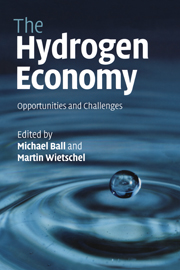Book contents
- Frontmatter
- Contents
- List of main contributors
- Preface
- Acknowledgements
- List of abbreviations
- 1 Scope of the book
- 2 Why hydrogen?
- 3 Non-renewable energy resources: fossil fuels – supply and future availability
- 4 Non-renewable energy resources: nuclear fuels
- 5 Assessment of the potentials for renewable energy sources
- 6 Carbon capture and storage
- 7 Energy-chain analysis of hydrogen and its competing alternative fuels for transport
- 8 Hydrogen today
- 9 Fundamental properties of hydrogen
- 10 Hydrogen production
- 11 Hydrogen storage
- 12 Hydrogen distribution
- 13 Key role of fuel cells
- 14 Hydrogen-infrastructure build-up in Europe
- 15 Building a hydrogen infrastructure in the USA
- 16 Hydrogen and the electricity sector
- 17 Hydrogen corridors
- 18 Macroeconomic impacts of hydrogen
- 19 Sustainable transport visions: the role of hydrogen and fuel-cell vehicle technologies
- 20 Energy-efficient solutions needed – paving the way for hydrogen
- 21 The future of hydrogen – opportunities and challenges
- Further reading
- Index
- References
5 - Assessment of the potentials for renewable energy sources
Published online by Cambridge University Press: 22 January 2010
- Frontmatter
- Contents
- List of main contributors
- Preface
- Acknowledgements
- List of abbreviations
- 1 Scope of the book
- 2 Why hydrogen?
- 3 Non-renewable energy resources: fossil fuels – supply and future availability
- 4 Non-renewable energy resources: nuclear fuels
- 5 Assessment of the potentials for renewable energy sources
- 6 Carbon capture and storage
- 7 Energy-chain analysis of hydrogen and its competing alternative fuels for transport
- 8 Hydrogen today
- 9 Fundamental properties of hydrogen
- 10 Hydrogen production
- 11 Hydrogen storage
- 12 Hydrogen distribution
- 13 Key role of fuel cells
- 14 Hydrogen-infrastructure build-up in Europe
- 15 Building a hydrogen infrastructure in the USA
- 16 Hydrogen and the electricity sector
- 17 Hydrogen corridors
- 18 Macroeconomic impacts of hydrogen
- 19 Sustainable transport visions: the role of hydrogen and fuel-cell vehicle technologies
- 20 Energy-efficient solutions needed – paving the way for hydrogen
- 21 The future of hydrogen – opportunities and challenges
- Further reading
- Index
- References
Summary
In this chapter, an assessment of the global and European potentials of renewable energy sources is given. With respect to hydrogen as a promising future energy carrier, a clear focus is put on electricity generation from renewable energy sources (RES), serving as a sustainable solution for producing hydrogen based on electrolysis (see also Chapter 16). Biomass gasification and solar-thermal technology provide further options to produce hydrogen using RES. In the following, first, different categories of renewable energy potentials are defined, followed by a general overview of the potentials on a global level and a more detailed picture of the European potentials of renewable energy sources. Finally, the global potential for biofuels is shortly addressed.
Potential categories
The possible use of RES depends in particular on the available resources and the associated costs. In this context, the term ‘available resources’ or RES potential has to be clarified. The RES potential might be represented by the overall theoretically available resources or might take into account different aspects that restrict the theoretically available resources. Subsequently, the RES-potential categories used within this book are described.
Theoretical potential The highest potential of an energy source is the theoretical potential. To derive the theoretical potential, general physical parameters have to be taken into account, based on the determination of the energy flow resulting from a certain energy resource within the investigated region. Examples are the kinetic energy of the wind, the total energy content of the existing biomass or the amount of solar energy radiated to a defined territory during one year. The theoretical potential consists of the overall physical energy supply available and represents a theoretically upper limit for the use of RES.
[…]
- Type
- Chapter
- Information
- The Hydrogen EconomyOpportunities and Challenges, pp. 135 - 167Publisher: Cambridge University PressPrint publication year: 2009
References
- 2
- Cited by

